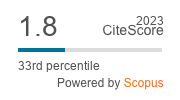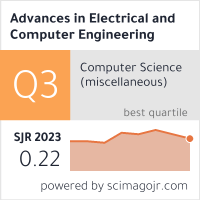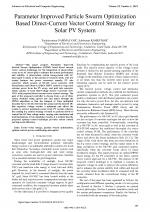| 1/2018 - 13 |
Parameter Improved Particle Swarm Optimization Based Direct-Current Vector Control Strategy for Solar PV SystemNAMMALVAR, P. |
| View the paper record and citations in |
| Click to see author's profile in |
| Download PDF |
Author keywords
solar energy, particle swarm optimization, optimal control, power conditioning, microgrids
References keywords
power(22), control(10), systems(7), energy(7), grid(6), current(6), voltage(5), system(5), generation(5), connected(5)
Blue keywords are present in both the references section and the paper title.
About this article
Date of Publication: 2018-02-28
Volume 18, Issue 1, Year 2018, On page(s): 105 - 112
ISSN: 1582-7445, e-ISSN: 1844-7600
Digital Object Identifier: 10.4316/AECE.2018.01013
Web of Science Accession Number: 000426449500013
SCOPUS ID: 85043243615
Abstract
This paper projects Parameter Improved Particle Swarm Optimization (PIPSO) based direct current vector control technology for the integration of photovoltaic array in an AC micro-grid to enhance the system performance and stability. A photovoltaic system incorporated with AC micro-grid is taken as the pursuit of research study. The test system features two power converters namely, PV side converter which consists of DC-DC boost converter with Perturbation and Observe (P&O) MPPT control to reap most extreme power from the PV array, and grid side converter which consists of Grid Side-Voltage Source Converter (GS-VSC) with proposed direct current vector control strategy. The gain of the proposed controller is chosen from a set of three values obtained using apriori test and tuned through the PIPSO algorithm so that the Integral of Time multiplied Absolute Error (ITAE) between the actual and the desired DC link capacitor voltage reaches a minimum and allows the system to extract maximum power from PV system, whereas the existing d-q control strategy is found to perform slowly to control the DC link voltage under varying solar insolation and load fluctuations. From simulation results, it is evident that the proposed optimal control technique provides robust control and improved efficiency. |
| References | | | Cited By «-- Click to see who has cited this paper |
| [1] F. Blaabjerg, Z. Chen, S. B. Kjaer, "Power electronics as efficient interface in dispersed power generation systems," IEEE Trans. Power Electron, vol. 19, no. 5, pp. 1184-1194, 2004, [CrossRef] [Web of Science Times Cited 1700] [SCOPUS Times Cited 2276] [2] Y. Yang, F. Blaabjerg, H. Wang, M.G. Simoes, "Power control flexibilities for grid-connected multi-functional photovoltaic inverters," IET Renewable Power Generation, vol.10, no.4, pp.504-513, 2016, [CrossRef] [Web of Science Times Cited 117] [SCOPUS Times Cited 153] [3] M. Unlu, S. Camur, E. Beser, B. Arifoglu, "A Current-Forced Line-Commutated Inverter for Single-Phase Grid-Connected Photovoltaic Generation Systems," Advances in Electrical and Computer Engineering, vol.15, no.2, pp.85-92, 2015, [CrossRef] [Full Text] [Web of Science Times Cited 4] [SCOPUS Times Cited 6] [4] D. Yazdani, A. Bakhshai, G. Joos, M. Mojiri, "A real-time extraction of harmonic and reactive current in a nonlinear load for grid-connected converters," IEEE Transactions on Industrial Electronics, vol.56, no.6, pp.2185-2189, 2009, [CrossRef] [Web of Science Times Cited 49] [SCOPUS Times Cited 62] [5] M. Asit, M. Viswavandya, M. Sthitapragyan, K. Prakash, S. Patra, "Modelling, simulation and optimisation of robust PV based micro grid for mitigation of reactive power and voltage instability," International Journal of Electrical Power & Energy Systems, vol.81, pp.444-458, 2016, [CrossRef] [Web of Science Times Cited 10] [SCOPUS Times Cited 14] [6] Y. A. Hajizadeh, M. A. Golkar, A. Feliachi, "Voltage control and active power management of hybrid fuel-cell/energy-storage power conversion system under unbalanced voltage sag conditions," IEEE Transactions on Energy Converters, vol. 25, no.4, pp.1195-1208, 2010, [CrossRef] [Web of Science Times Cited 92] [SCOPUS Times Cited 119] [7] A. Cagnano, E. Tuglie, M. De Liserre, R. A. Mastromauro, "Online optimal reactive power control strategy of PV inverters," IEEE Transactions on industrial Electronics, vol.58, no.10, pp.4549-4558, 2011, [CrossRef] [Web of Science Times Cited 160] [SCOPUS Times Cited 206] [8] E. Sundaram, M. Venugopal, "On design and implementation of three phase three level shunt active power filter for harmonic reduction using synchronous reference frame theory," International Journal of Electrical Power & Energy Systems, vol.81, pp.40-47, 2016, [CrossRef] [Web of Science Times Cited 37] [SCOPUS Times Cited 61] [9] T. Zaveri, B. Bhalja, N. Zaveri, "Comparison of control strategies for DSTATCOM in three-phase, four-wire distribution system for power quality improvement under various source voltage and load conditions," International Journal of Electric Power Energy System, vol.43, pp.582-594, 2012, [CrossRef] [Web of Science Times Cited 54] [SCOPUS Times Cited 72] [10] D. Kairus, R. Wamkeue, B. Belmadani, M. Benghanem, "Variable Structure Control of DFIG for Wind Power Generation and Harmonic Current Mitigation," Advances in Electrical and Computer Engineering, vol.10, no.4, pp.167-174, 2010, [CrossRef] [Full Text] [Web of Science Times Cited 10] [SCOPUS Times Cited 13] [11] S. Li, L. Xu, T. A. Haskew, "Control of VSC-based STATCOM using conventional and direct-current vector control strategies," International Journal of Electrical Power & Energy Systems, vol.45, no.1, pp.175-186, 2013, [CrossRef] [Web of Science Times Cited 36] [SCOPUS Times Cited 45] [12] S. Li, I. Jaithwa, R. Suftah, X. Fu, "Direct-current Vector Control of Three-phase Grid-connected Converter with L, LC, and LCL Filters," Electric Power Components and Systems, vol.43, no.14, pp.1644-1655, 2015. [CrossRef] [Web of Science Times Cited 8] [SCOPUS Times Cited 9] [13] A. L. Alhamdawee, N. F. Mailah, M. A. Radzi, S. B. Shafie, S. Hajighorbani, A. Q. Turki, "Comparison of developed FLC and P&O MPPT algorithms for improving PV system performance at variable irradiance conditions," World Journal of Engineering, vol. 13, no. 6, pp.494-499, 2016, [CrossRef] [Web of Science Times Cited 2] [SCOPUS Times Cited 4] [14] A. Durusu, I. Nakir, A. Ajder, R. Ayaz, H. Akca, M. Tanrioven, "Performance Comparison of Widely-Used Maximum Power Point Tracker Algorithms under Real Environmental Conditions," Advances in Electrical and Computer Engineering, vol.14, no.3, pp.89-94, 2014, [CrossRef] [Full Text] [Web of Science Times Cited 10] [SCOPUS Times Cited 12] [15] F. Liu, Y. Zhou, S. Duan, J. Yin, B. Liu, F. Liu, "Parameter Design of a Two-Current-Loop Controller Used in a Grid-Connected Inverter System with LCL Filter," IEEE Transactions on Industrial Electronics, vol.56, no.11, pp.4483-4491, 2009, [CrossRef] [Web of Science Times Cited 210] [SCOPUS Times Cited 264] [16] M. Gecic, M. Kapetina, D. Marcetic, "Energy Efficient Control of High Speed IPMSM Drives - A Generalized PSO Approach," Advances in Electrical and Computer Engineering, vol.16, no.1, pp.27-34, 2016, [CrossRef] [Full Text] [Web of Science Times Cited 5] [SCOPUS Times Cited 6] [17] G. Chen, L. Liu, Y. Gua, S. Huang, "Multi-objective enhanced PSO algorithm for optimizing power losses and voltage deviation in power systems," COMPEL: The International Journal for Computation and Mathematics in Electrical and Electronic Engineering, vol. 35, no.1, pp.350-372, 2016, [CrossRef] [Web of Science Times Cited 27] [SCOPUS Times Cited 42] [18] K. Dezelak, P. Bracinik, M. Hoger, A. Otcenasova, "Comparison between the particle swarm optimisation and differential evolution approaches for the optimal proportionalintegral controllers design during photovoltaic power plants modelling," IET Renewable Power Generation, vol.10, no.4, pp.522-530, 2016, [CrossRef] [Web of Science Times Cited 18] [SCOPUS Times Cited 18] [19] F. Padula, A. Visioli, "Tuning rules for optimal PID and fractional-order PID controllers," Journal of process control, vol.21, no.1, pp.69-81, 2011, [CrossRef] [Web of Science Times Cited 319] [SCOPUS Times Cited 427] [20] R. Eberhart, J. Kennedy, "A new optimizer using particle swarm theory," Sixth Symposium on Micro Machine and Human Science, IEEE Service Center, Piscataway, pp.39-43, 1995, [CrossRef] Web of Science® Citations for all references: 2,868 TCR SCOPUS® Citations for all references: 3,809 TCR Web of Science® Average Citations per reference: 137 ACR SCOPUS® Average Citations per reference: 181 ACR TCR = Total Citations for References / ACR = Average Citations per Reference We introduced in 2010 - for the first time in scientific publishing, the term "References Weight", as a quantitative indication of the quality ... Read more Citations for references updated on 2024-10-22 04:24 in 135 seconds. Note1: Web of Science® is a registered trademark of Clarivate Analytics. Note2: SCOPUS® is a registered trademark of Elsevier B.V. Disclaimer: All queries to the respective databases were made by using the DOI record of every reference (where available). Due to technical problems beyond our control, the information is not always accurate. Please use the CrossRef link to visit the respective publisher site. |
Faculty of Electrical Engineering and Computer Science
Stefan cel Mare University of Suceava, Romania
All rights reserved: Advances in Electrical and Computer Engineering is a registered trademark of the Stefan cel Mare University of Suceava. No part of this publication may be reproduced, stored in a retrieval system, photocopied, recorded or archived, without the written permission from the Editor. When authors submit their papers for publication, they agree that the copyright for their article be transferred to the Faculty of Electrical Engineering and Computer Science, Stefan cel Mare University of Suceava, Romania, if and only if the articles are accepted for publication. The copyright covers the exclusive rights to reproduce and distribute the article, including reprints and translations.
Permission for other use: The copyright owner's consent does not extend to copying for general distribution, for promotion, for creating new works, or for resale. Specific written permission must be obtained from the Editor for such copying. Direct linking to files hosted on this website is strictly prohibited.
Disclaimer: Whilst every effort is made by the publishers and editorial board to see that no inaccurate or misleading data, opinions or statements appear in this journal, they wish to make it clear that all information and opinions formulated in the articles, as well as linguistic accuracy, are the sole responsibility of the author.





